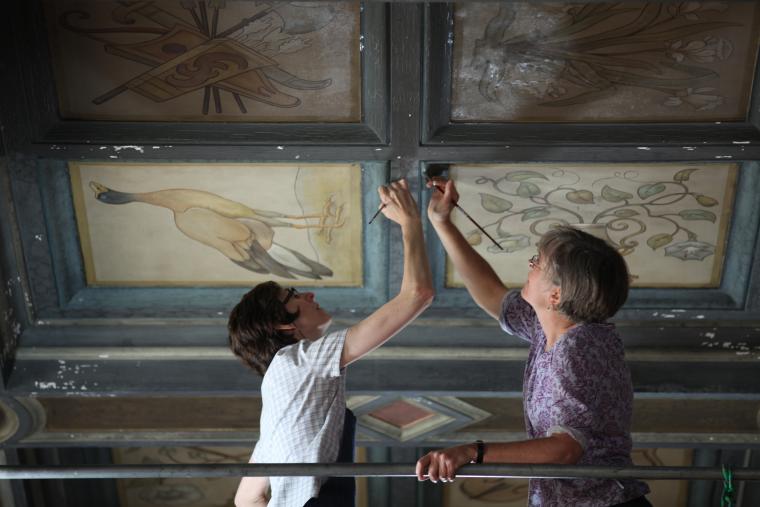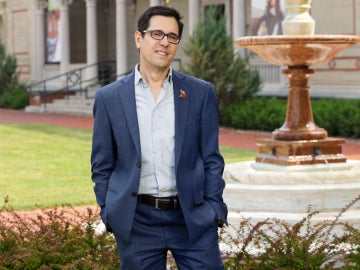Looking Up
October 9, 2014
Amanda Nagy

ICA conservators Andrea Chevalier, left, and Wendy Partridge touch up fine details. The work involves reaching overhead while stationed on a 31-foot scaffold.
Photo credit: John Seyfried
Nearly a century of accumulated dirt, grime, and pollution has obscured one of the more captivating features inside the Allen Memorial Art Museum: the grand, painted ceiling of the King Sculpture Court.
As part of the original design for the 1917 building, architect Cass Gilbert hired painter Frederick J. Wiley to decorate the upper walls and ceiling of the museum’s soaring central space, later named for the museum’s first curator, Hazel B. King. The faux-coffered ceiling is adorned with 100 canvas paintings of animal and foliage designs in emulation of a 16th-century French style, while eight canvas panels on the upper walls feature verses by the American transcendentalist writer Christopher Pearse Cranch, and 40 others display decorative painting.
Environmental factors over time have compromised the condition of the artwork, resulting in some aesthetic alterations. The ceiling, plasterwork, and walls display some staining from water damage and noticeable paint loss, particularly on the upper walls, and overpaint from a previous era has marred their surfaces, which had never before been properly cleaned.
A large-scale effort by the ICA-Art Conservation of Cleveland (ICA) is returning the artwork and surrounding area to its former glory, and museum visitors get to witness the transformation in action. Since the summer, a team of conservators has been working one section at a time on 31-foot scaffolding. The museum will remain open throughout the process. The project is on schedule to be completed by the 2015 commencement weekend.
During the academic year, Oberlin students also will have an opportunity to learn about the complex issues and decision-making that conservators face in their profession. ICA painting conservator Heather Galloway, who is involved in the museum’s conservation project, is teaching a half-semester course on the topic, offered through the art department.
Galloway explains that the skill-set of a conservator is often referred to as a three-legged stool. The job requires hand skills, a background in art history or archaeology, and basic understanding of the sciences. And, in cases like this, the ability to overcome any fear of heights. “Each of these components--the scientist, the conservator, the historian--present possibilities.”
A labor of love
In 2011, the museum completed a two-year renovation project that emphasized environmental sustainability. With the installation of geothermal wells and new energy-efficient mechanical systems to meet stringent climate control requirements, the project improved the way art collections are cared for while preserving the appearance and footprint of the building.
Since 1917, air quality and museum practices have changed dramatically. In the early days of the museum, windows were left open and works were lit by natural light, says Andria Derstine, the John G.W. Cowles director of AMAM. Smoking was acceptable indoors.
In July 2013, an initial test cleaning of the ceiling art and architectural moldings revealed that the original color palette of the painting had been darkened so significantly as to make it appear perpetually in shadow. Galloway says a high-humidity incident at one point in the building’s history caused water to collect on the ceiling, resulting in some staining. “The museum has done tremendous work in addressing the building environmentally. A building’s HVAC system and humidity control is unbelievably vital for the health and safety of the building and the artworks.”
Compared to an easel painting, the ceiling project is a massive undertaking that can’t be done alone. Most of the work has involved cleaning, consolidating loose paint when necessary, reattaching the canvas, and retouching losses. The eight poetry panels in the clerestory area (the walls on the level of the arched windows) have become unreadable from both dirt and a previous overpaint campaign, so conservators will remove the overpaint to reveal the original background color and restore contrast.
Proceeding alongside the $500,000 conservation project are plans to install soft up-lighting that will illuminate the ceiling and poetry, and the museum’s century-old chandelier, original to the building, will be conserved and reinstalled in the sculpture court. Derstine found records of Gilbert’s intention to install recessed lighting; those plans didn’t pan out during construction. “I feel like we’ll be completing his plan,” she says. Oberlin Board of Trustee member Alan Wurtzel ’55 was the lead donor for the ceiling conservation project. The funding campaign, to which numerous other alumni and friends have contributed, is ongoing. Funding for the lighting project comes from Pat Shanks ’63 and Merrill Shanks ’61.
Based on Derstine’s archival research, it appears that Wiley, the artist commissioned by Gilbert, executed the paintings on canvas in his New York studio and shipped them to Oberlin. On site, craftsmen affixed the canvas to plaster, most likely with animal skin glue. “Painters at the time were very different animals,” Galloway says, concerning those who painted the walls and moldings adjacent to the canvases. “Their technology has changed so much since 1917, and I’d like to students to understand some of the challenges they faced. For example, where a single painter today can apply a flat finish to a wall, it took at least two painters in the previous century—one to apply the paint, and one to hide the brush strokes by stippling the surface. It required more labor and expense.”
A legacy preserved
This fall’s course module on conservation is Galloway’s third course with Oberlin College. The museum has sponsored these courses through an academic programs grant from the Andrew W. Mellon Foundation. Last spring, Galloway separately met with Associate Chemistry Professor Catherine Oertel’s first-year seminar, “Materials at the Museum,” to discuss the ceiling work.
“As a conservator, it doesn’t matter what you think you should do,” explains Galloway. “The materials and a knowledge of their aging characteristics offer evidence to you. Then, you have to balance that with budget, health, and safety. I want students to understand how many complicated factors come to the table. I want to foster an understanding and sympathy with how these decisions are made. Conservation can bring passionate, emotional debate, yet there’s no one right way.”
For Gilbert, who was inspired by medieval and European Renaissance styles, the museum was an artwork in and of itself, says Derstine. “Oberlin’s campus has such phenomenal architecture. Cass Gilbert was trying to achieve a feeling of a Renaissance palace. He paid careful attention to detail and craftsmanship; the colors harmonize with the exterior of the building. It’s important to maintain and celebrate this historic infrastructure. As we approach the museum’s centennial, I want all of our patrons and visitors to reflect on the important work that we’ve done to preserve this legacy.”
And when the project is complete, visitors should remember to look up.
You may also like…
Interview: Jon Seydl, John G.W. Cowles Director of the Allen Memorial Art Museum
Get to know Jon Seydl, the new John G.W. Cowles Director of the Allen Memorial Art Museum at Oberlin.
Oberlin College Names Jon Seydl as Director of the Allen Memorial Art Museum
Oberlin College and Conservatory is pleased to announce the appointment of Jon Seydl as the new John G. W. Cowles Director of the Allen Memorial Art Museum. He will begin his tenure on July 1.
Longtime Allen Memorial Art Museum Director Andria Derstine Announces Departure
After more than a decade of exemplary leadership, Andria Derstine is leaving her post as the John G. W. Cowles Director of the Allen Memorial Art Museum (AMAM) at Oberlin College


